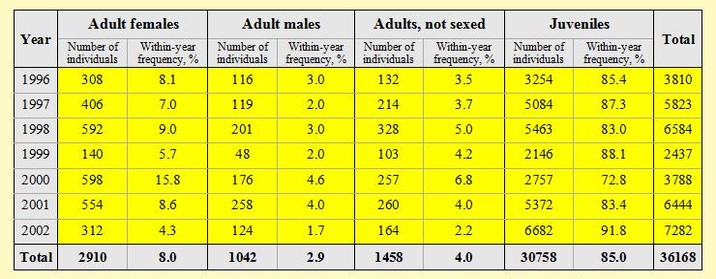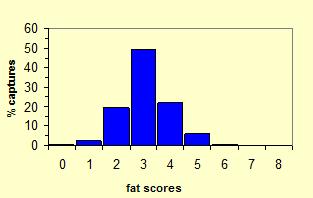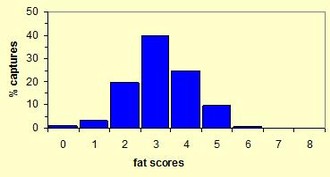I risultati - Gruppo Inanellamento Limicoli (GIL, Napoli)
Menu principale:
- Home Page
- L'Associazione
-
Ricerche in atto
- Migrazione autunnale Allodola
- Migrazione primaverile Tordo
- Ali Tordo bottaccio in Campania
- Stazione Monte Vaccaro
- Riserva Naturale Foce Volturno
- Inanellamento Medio Volturno
- Avifauna svernante
- Avifauna Foce Neto e Sila
-
Ricerche concluse
- Ali Turdidi e Beccacce ATC LT 2
- Stazione Malga Rosello
- Migrazione Caradriiformi
- Progetto Rondine
- Migrazione autunnale Tordo
- Ali Turdidi e Beccacce ATC CE
- Progetto Alauda 2000
- Osservatorio Roccolo Ganda
- Atlante Migrazioni Puglia
- Download
- News
I risultati
Sex ratio and biometrics of the European Swallow (Hirundo rustica) on autumn migration in southern Italy
Sergio Scebba, Giuseppe La Gioia, Silvia Capasso & Gabor Lövei
SUMMARY
Since 1991, the Gruppo Inanellamento Limicoli (G.I.L., Napoli) has been working on a long-
In total, 36,222 Swallows were mist-
Measurements of wing length, third primary length and body mass indicated that young Swallows were smaller than older birds. Most birds had medium fat reserves; the proportion of Swallows with high fat scores (5 and 6) tended to be higher in adults than in juveniles.
Only two birds carried rings from elsewhere, ringed in Germany and in Slovenia; eleven of the Swallows ringed at the Lake of Lesina have produced long distance recoveries: in the Central African Republic, Congo, Cameroon, Libya, Malta and Greece.
INTRODUCTION
The European Swallow (Hirundo rustica) is distributed over the whole of Italy, although in areas under modern agricultural cultivation and in urbanized centres is on the decrease (Niederfriniger 1993). A similar situation has been documented in several other countries: Finland (Saurola 1997), Great Britain and Ireland (Gibbons et al. 1996, JNCC 1996), Switzerland (Weggler et al. 2000) and Kazakhstan (Gavrilov et al. 2002). The main causes of decline seems to be the high intensity of agricultural cultivation and the modernization of animal husbandry (Jenni 1997; Weggler et al. 2000, Møller 2001).
To find out about the extent and causes of this general decline, the Italian Ringing Centre started the "Swallow Project" in 1994. In 1997 this became an EURING project and was extended to most of other European countries. The project has two important aims: 1) to describe the variability of survival rates and dispersal; 2) to study the impact of human activities on Swallow populations (Jenni 1997).
Since 1991, the Gruppo Inanellamento Limicoli (G.I.L., Napoli), the first such group in southern Europe, has been working on a long-
This paper gives a brief summary of the Swallow ringing activity between 1996 and 2002 at the Lake of Lesina (Apulia region), the location of one of the biggest migratory Swallow roosts of southern Italy.
STUDY AREA AND METHODS
The study was done near the mouth of the Lauro canal system (41.54N 15.34E), on the eastern side of the Lake of Lesina (near Foggia, Southern Italy). The Lake of Lesina is a shallow brackish water lake of 5328 ha; the eastern third of which is covered by extensive reedbeds. The reedbeds are dominated by Phragmites australis, with some Arundo donax and Typha angustifolia. The surrounding area, made up of pastures and cultivated fields, provides an excellent feeding-
Roosting Swallows were tape-
All Swallows were ringed but only adults were all measured. Due to the large numbers captured and in order to release birds as quickly as possible, only the first 100 juveniles were measured every evening. The following data were collected: body mass at 0.1 g accuracy, fat score (following a scale ranging from 0 (no fat) to 8 (maximum amount of subcutaneous fat) as proposed by Kaiser 1993), wing length (maximum chord method, Svensson 1992) and third primary length (measured to the nearest 0.5mm, Berthold & Friedrich 1973). Age and sex were established following Svensson (1992): individuals with a tail fork ?59 mm were classified as males, and those with ?50 mm as females. Individuals with intermediate values, or those with broken streamers were unsexed.
RESULTS AND DISCUSSION
The number of Swallows using the roost in autumn was estimated at dusk to be between 1,000 and >10,000 birds. In total, 36,222 Swallows were mist-

Table 1. The age and sex class composition of Swallows ringed at the Lake of Lesina, southern Italy, between 1996-
Measurements of wing length, third primary length and body mass (Table 2) indicated that young Swallows were smaller than older birds. This is the case for many other passerine species (Alatalo et al. 1984). The mean body mass of juveniles (19.3 ± 1.82g, n = 12,429) was lower than that of adults (20.1 ± 1.94g, n = 4,478). All the differences between juvenile and adult were statistically significant (p<0.001). These values were similar to those calculated for 24 Italian roosts (juveniles 19.26 ± 1.76g, n = 7,028; adults 20.57 ± 1.93g, n = 1,562, Pilastro et al. 1998).

Table 2. Biometric data for Swallows ringed on Lake of Lesina, southern Italy, between 1996-
Figures 1 and 2 summarise the data for fat scores of juveniles (n = 12,485) and adults (n = 4,451), respectively. Most birds had medium fat reserves (score 3, 39.9% and 49.1%, respectively). The proportion of Swallows with high fat scores (5 and 6) tended to be higher in adults (10.8%) than in juveniles (6.5%), even though this trend was not statistically significant. None of the birds had a fat score 8 and only one adult had a fat score of 7. The mean body mass of birds with fat score = 0 was 17.36g (± 1.28g, n = 86) for juveniles, and 18.15g (± 1.81g, n = 59) for adults. Detracting this from the mean body mass, 1.94g and 1.95g as mean fat load for the two age groups results. When considering only the heaviest 25% of individuals (the value usually considered as mean body mass at departure, see Alerstam & Lindström 1990), the fat load was 4.4g in the juveniles and 4.6g in the adults. This corresponded to 25.3% of the lean body mass of both juveniles and adults. The body mass of the heaviest juvenile Swallow trapped in this study (29.3g) corresponding to 68.8% of the mean body mass of lean birds.

Figure 1. Frequency distribution of fat scores of juvenile Swallows trapped on the Lake of Lesina, southern Italy, between 1996-

Figure 2. Frequency distribution of fat scores of adult Swallows trapped on the Lake of Lesina, southern Italy, between 1996-
Although there was variability among years with respect to sex and age classes, the comparisons among different years is confounded by the different operation schedule, namely the different hours of evening capture. This is suggested to significantly influence age class composition (Scebba et al. 2001). However, with the similar evening operation regime in the last three years, we can cautiously indicate a successful year for reproduction in 2002, as the relative share of juveniles was considerably higher than in the two earlier years (Table 1).
Among these 36,139 ringed Swallows, only two birds carried rings from elsewhere. One was ringed in Germany and another one in Slovenia, both during autumn migration. Eleven of the Swallows ringed at the Lake of Lesina have produced long distance recoveries: seven individuals were retrapped during autumn migration (from 7 October to 22 November) in the Central African Republic (four), the Congo (two) and Cameroon (one). Two birds were recovered in Malta, one in Libya and an other one in Greece during spring migration. Year-
The scarce recapture rates indicated that Swallows passing through the Lake of Lesina probably originated from areas where there was no massive ringing effort. A more detailed analysis of trends in age class and body mass variability from year-
ACKNOWLEDGEMENTS
This study was partially supported by the Earthwatch Institute, Cambridge, Mass., USA. We thank the field assistance provided by EarthCrops volunteers in years 1998-
REFERENCES
Alerstam, T. & Lindström, A. 1990. Optimal bird migration: the relative importance of time, energy and safety. In: Gwinner, E. (ed.). Physiological and Ecophysiological Aspects of Bird Migration.
Berthold, P. & Friedrich, W. 1979. Die Federlänge: ein neues nützliches Flügelmass. Vogelwarte
Gavrilov, E. I., Gavrilov, A. E., Kovshar, V. A., 2002. Long-
Gibbons, D. W., Avery, M., Baillie, S. R., Gregory, R. D., Kirby, J. R., Porter, R., Tucker, G. M. & Williams, G. 1996. Bird species of conservation concern in the United Kingdom, Channel Island and Isle of Man: revising the Red Data List. RSPB Conserv. Rev.
Jenni, L. 1997. EURING Swallow Project. Field manual.
JNCC, 1996. Birds of Conservation Importance. Press release (31 May 1996). Joint Nature Conservation Committee, Peterborough.
Kaiser, A. 1993. A new multi-
Møller, A. P. 2001. The effect of dairy farming on Barn Swallows (Hirundo rustica
Niederfriniger, O. 1993. In Meschini, E. & Frugis, S. (eds.) Atlante degli uccelli nidificanti in Italia. Suppl. Ric. Biol. Selvaggina
Pilastro, A., Spina, F., & Micheloni, P. 1998. Geographical variation in pre-
Saurola, P. 1997. Recoveries of Swallows Hirundo rustica
Scebba, S., La Gioia, G., Moschetti, G. & Lövei, G. 2001. Inanellamento al roost: influenza dell'orario di cattura sulla composizione in classi d'età. Atti Convegno "La Rondine in Italia: status attuale, ecologia e gestione"
Svensson, L. 1992. Identification guide to European passerines.
Weggler, M. & Widmer, M. 2000. Vergleich der Brutvogelbestände im Kanton Zürich 1986-
Paper n°. 51 from the Gruppo Inanellamento Limicoli (G.I.L., Napoli)